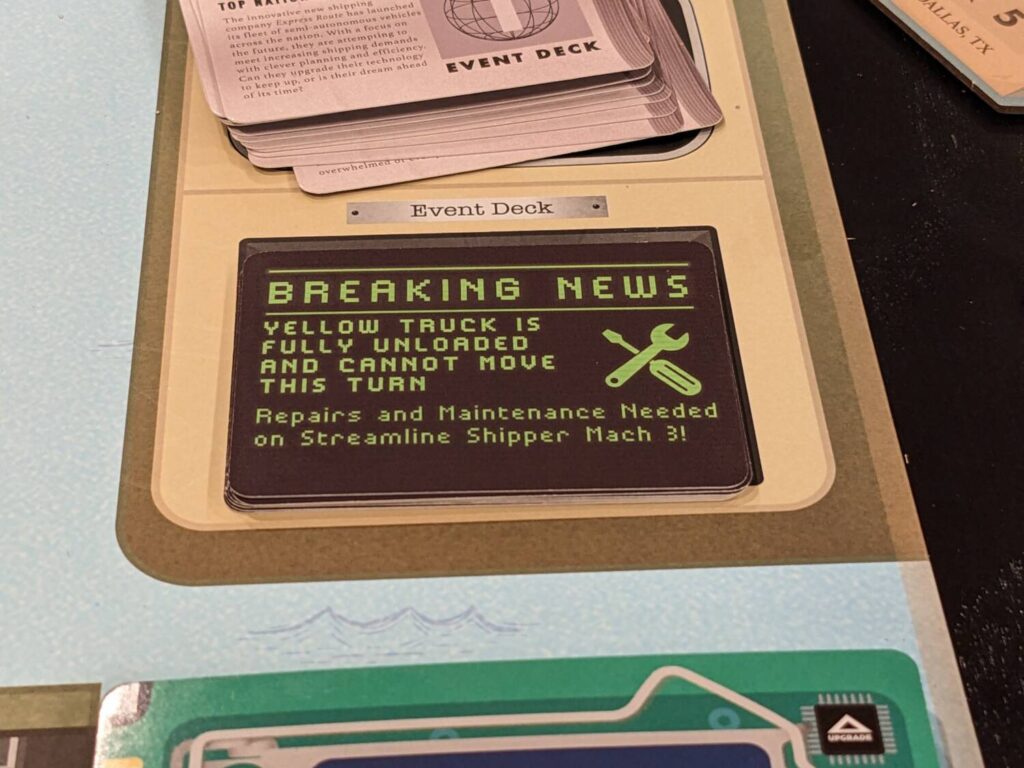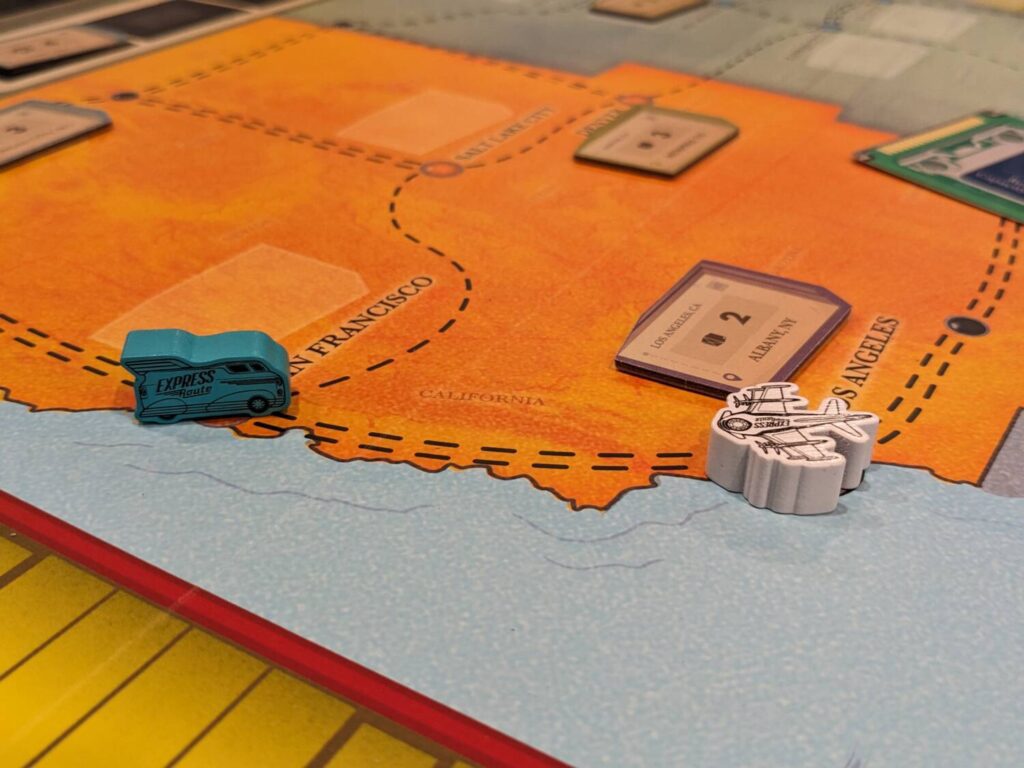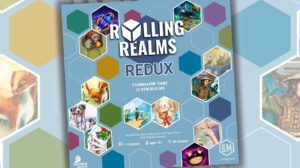Disclosure: Meeple Mountain received a free copy of this product in exchange for an honest, unbiased review. This review is not intended to be an endorsement.
Do you ever play a game solo where you get smoked so badly that you are sure you are playing the game wrong?
A few times a year, that happens to me, too. This is especially true in some of the video games I play from time to time, before realizing that I wasn’t focused on attacking a boss character’s weak spots, or using the wrong weapon or spell or something.
In a board game, it’s pretty rare. I usually read the rules and do a dummy play so that I have the game down pat.
I recently got Express Route (2023, The OP) to the table with my family. My son bailed during the teach—”Daddy, this looks boring”—so my daughter and I did a first play. (And, look: you can’t always trust kids. But to his credit, my son bailed before the game began so it didn’t take much time to replace him.)
My daughter and I lost our first game of Express Route on maybe the sixth or seventh turn. No problem, I was sure I got something wrong in the rules…but I was a little surprised at how easy it was to lose. Went back, read the entire rulebook again, then played the game on my own as a solo player (and we’ll come back to the term “solo play” in a moment).
I played a second time, then lost on maybe the eighth turn; in reality, the game was over before that eighth turn. In a bit of frustration—”maybe I’m just getting dumber”, I thought—I played two more times, and lost by the tenth turn both times.
The next morning, I started my work day by watching the (as usual) excellent teach video for Express Route from Rodney and Watch It Played. Then, I watched that video a second time. It was an interesting moment:
- I had the rules 100% right.
- Express Route isn’t hard, it is impossible. And maybe it is NOT impossible—I won’t play it more than the four times I have already tried it—but I am not seeing a legitimate path to consistently winning without a lot of luck of the draw.
In a strategy game, this is a no-fly zone.

Pick Up and Deliver…The Future!
Express Route is a 1-4 player pick-up and deliver game tasking players to work cooperatively and deliver a number of packages over the course of no more than 24 turns to achieve its win condition. During setup, each player is given the role of one of 11 Specialists, which provide asymmetry to both setup and player actions. They are also given a player board tracking the ability of their specific form of interaction with the delivery vehicles in the game.
Players have shared access to three delivery trucks and a cargo plane. The game’s timer is tied to two processes: a Demand Track, and an Event Deck. If the event deck’s 24 cards run out and you need to draw another one, game over. If the Demand Track—which begins the game at 15—ever reaches 36 or higher, game over.
On a turn, players must add 1-2 new packages to the map. This always raises the Demand Track, anywhere from one to six spots per package. That track is also broken up into green, yellow, and red zones. If players are in the green zone, they add two “Low Demand” packages ranging in value from 1-3 demand value points. Yellow range packages (“High Demand”) range from 4-6 demand value points.
The way this Demand Track works, its minimum value is 10. (I never saw it go below 15.) It moves to yellow as soon as players hit 23. That means players will often be right on the edge of the green section of demand by their second turn, and usually into yellow by their second turn if they can’t deliver a package on their first turn.
But before you get to even take your first action, you have to interact with the event deck, featuring Breaking News cards. Most are negative, and typically ask players to not move into certain cities or regions on the map. Some are funnier—you’ll have to randomly dump the cargo from a specific vehicle and not move that same vehicle for an entire turn. (In every case where I saw one of those cards, I naturally had cargo loaded onto the named truck.)
After these first three steps—add packages, adjust demand, reveal event—you get to take up to three actions. Using battery tokens, players get to work together on how to most efficiently use their individual turn.
Here are your choices:
- Activate a vehicle to move 1-3 spaces (trucks) or from one airport to another airport (the plane).
- Load a package onto a vehicle.
- Unload a package from a vehicle.
- Move a package from one loaded vehicle to another vehicle, assuming it has space.

Yes, you are right—this means that on your first turn of the game, assuming you don’t have a vehicle sitting in the same location as a package, that it will take four actions to deliver a package: move to a city with a package, load the package, move to the package’s destination, then unload the package. This essentially guarantees that your team won’t deliver a package on the first turn of the game.
There’s another thing I haven’t told you: when play begins, you can’t do the same action twice with the same vehicle. So, you can’t, say, move the plane twice, or load and unload with the orange truck, on the same turn.
There’s a puzzle here, which I can appreciate. I complain often that games have gotten a bit too easy, and Express Route goes in the opposite direction. Express Route is the Dark Souls of pick-up and deliver board games, to reference one of the hardest video games I’ve ever played.
But at a minimum, it’s annoying (I used other words when I read the rules) to use an action when I’m in the destination city of a package to unload it. The manual is funny on this point—it’s a “free action” to deliver the package, but as the Watch It Played video makes clear, you have to take an unload action for a package to move out of a vehicle to be delivered.
Sigh.
Delivered packages are currency in Express Route. They will eventually fulfill the only way you can win: deliver eight packages, four of which have to meet certain variable conditions determined at setup (like two with destinations in the Northeast, for example). Packages can also be used to purchase upgrades for the team—expanding storage capacity in your delivery fleet, or providing more options when adding packages to the map. One upgrade gives players a chance to add a purple battery token, which replaces one of the silver battery tokens you received during setup to take one of your three actions each turn.
Purple batteries are the only way to take a single action twice on the same turn. These upgrades are valuable and make the fleet more efficient.
So, the game is tough, and there is an interesting puzzle hiding here somewhere. But does any of this make Express Route fun?

No
Even if Express Route was a tad easier, or games began with the Demand Track at 10, I’m not sure that would change my opinion.
The puzzle elements seem pretty scripted. Players must remove one of the high-demand packages to begin play, so each game has seen me trying to grab the 4- or 5-demand packages first for delivery. (Those are also normally a short-range distance delivery.) I don’t see any way players could try to race and deliver eight packages before the Demand Track hits 36 without upgrading the fleet, so upgrades are a must. That means you will probably spend your first few packages on upgrades.
And some of those upgrades seem significantly more important than others. Getting the upgrade to give players a fourth action is a no-brainer as the first pursuit. Getting purple batteries is another. Removing the lock token on the Demand Track–boosting your chances of not losing just a tad, by changing the end game condition on this track from 36 to 40–is also a no-brainer. In every game of Express Route, you are going to go after those first. More actions is good, right?
Now I like the idea that you are likely going to lose, or win this game at the last possible moment. Sky Team gave me similar vibes, and I keep coming back to that game because it’s got that nice balance of tension to go along with a chance to win. I don’t see any format where players cruise to victory in Express Route; that might be a feature in the eyes of some, but not others. As someone who has never even made it to the game’s halfway point of 12 turns, I had four deflating experiences playing this game.
A note about solo play: Express Route is the same whether you play it alone or with up to three other people. You can play with just one Specialist and one player board, four Specialists and four player boards, or some combination. What this really means: you can take six, eight, 12, or 24 individual turns. I preferred to take all of the turns, but I like that there are options here to forge your own path.
In addition, I like that The OP and designer Patrick Marino provided a number of different scenarios to alter the base game setup for those who are invested in exploring the design.
My wife, who completed a Pandemic: Season One campaign with me a couple of years ago, was reading near the game table as I finished my fourth play. “I’m happy to play if you want another player,” she offered.
“I wouldn’t bother,” I replied. “We are going to lose no matter who is sitting here!”












Add Comment